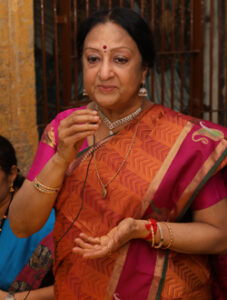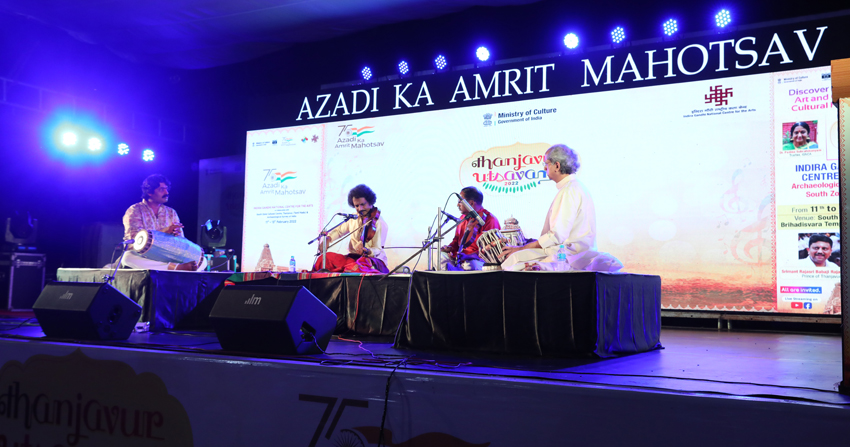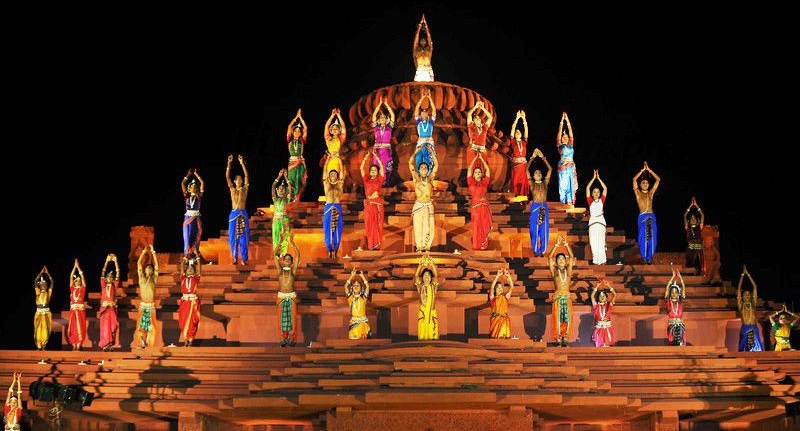Recently, IGNCA in collaboration with the South Zone Cultural Centre and Archaeological Survey of India organised a 3 day cultural fiesta celebrating the culture of Thanjavur through literature music and dance. This was held under the Azadi Ka Amrit Mahotsav (AKAM) scheme launched by the Ministry of Culture which seeks to mark 75 years of India’s independence through focusing on our heritage as well as remembering our freedom fighters. Curated by noted dancer scholar Padma Bhushan Dr Padma Subrahmanyam, the event included concerts, demonstrations, talks, and workshops. Being the cradle of the arts for the region, Thanjavur attained excellence in various art and craft forms, as seen in the magnificent UNESCO heritage Brihadeeshwara temple, Chola bronzes, Tanjore paintings and the music and dance of the region.
The unofficial start of the festival was in the precincts of the Brihadeeshwara temple, on the first floor of the towering dome, which is not usually open to the public. The inner walls are adorned with stone sculptures of Shiva depicting 81 dance poses, or “karanas”; here Dr Padma Subrahmanyam’s students demonstrated through dance, what each sculpture depicted. Several of the students who were there were transfixed – “we have studied each movement for years; to physically see the actual sculptures is surreal” said Veena Nair, of the Bharatanatyam and Mohiniattam dancing sister duo, Nair Sisters. Later during the festival, a 10 hour video of each of the poses was released.
The inauguration ceremony opened with auspicious strains of the “nadaswaram” (in the North, the equivalent instrument is the shehnai whose notes signal an auspicious event). Thanjavur’s last rulers were Maratha, before the British deposed them; it was appropriate that the festival was addressed by the current head of the erstwhile Bhonsle ruling family, Shrimant (Babaji) Shivaji Rajah Bhonsle Chattrapati, who takes an active interest in all things related to Thanjavur, and incidentally is the INTACH convenor for the district.
A brief ritualistic dance (kauthuam)that used to traditionally be done in the temple corridors, preceding the temple deity during the “uttsavam” by Charumathi Chandrasekaran was entrancing. The simple traditional movements were a refreshing change from current Bharatanatyam repertoire. She is the grand-daughter of Guru Kittapa Pillai, descendent of one of the Tanjore quartet who codified current day Bharatanatyam.
The online lecture by Sri Aravinth Kumarsawamy from Singapore brought in a global perspective of Thanjavur and the Cholas domination of the South East Asian region.
A workshop on how the ancient palm leaf manuscripts (there are more than 40000 in the Saraswati Mahal Library) are preserved and stored was an eye opener. The erudite Dr Perumal has done yeoman service in meticulously maintaining the library’s contents; the current head Dr S Sudershan is also a scholar of repute.
A Harikatha concert, featuring Rukmini’s wedding to Lord Krishna was performed by Dr Prameela Gurumurthy from Chennai; she was accompanied vocally by her two erudite scholar disciples, both of whom are research scholars in Chennai.
The evening concerts featured a newly curated piece, by Dr Padma Subrahmanyam, entitled “Sangam to Sadir – pearls from Tamil literature”. Whilst the period the subject covered must have entailed huge research and immense scholarship, the dance picturisation by the doyen’s three disciples was not perhaps as awe inspiring. Hearing that the music for each piece was also composed by Dr Padma Subrahmanyam was an eye opener.
[adrotate group=”9″]
Surprisingly, the next piece was Bharatanatyam too; one would have preferred a different art form. This featured the disciples of the iconic 92 year old Guru Kalyanasundaram; his totally riveting enunciation of “nattuvangam” was indeed a highlight of the concert. The passion which he exhibited had “rasa” and “asar”. Unusually, his handsome son Hari Krishna danced too.
The following day, the erudite lecture by Dr Rajeshri Ramakrishna, practising musician as well as Head of Music department University was fascinating. An important takeaway was “the theory of music followed the practise; so while we study to learn, for a performer it’s only the performing tradition one has to focus on. “Guru mukha” learning is essential for this musical tradition to flourish” she said.

The day featured two rousing recitals of “naamasankeertan”; the first was by a 13 member troupe from Chennai, the Gnanananda Naamsankeerthan Mandali. Their rousing songs, sung in unison created a powerful ambience of devotion; Dr Padma Subrahmanyam explained “the common thread of Bhakti runs through all our art traditions, and it is what has cemented our country. Thanjavur despite having had so many different rulers exemplifies this.” The 5 year Vitthal, enthusiastically keeping time on his miniature mridangam was a delight. One learnt that all “naamkeertan” ends with a hymn to Hanuman, the ultimate Bhakt.
The second was an “abhang” concert by Mumbai’s “Abhang King” Ganesh Kumar, who incidentally also heads Insync TV, the nations premier 24 hour non Bollywood music and dance channel. Ganesh Kumar is a Tamil from the Thanjavur district, his music a living example of the intermingling of the two traditions.
[adrotate group=”9″]
The workshop on Tanjore paintings by the State awardee painter brothers M Ramesh and M Mahesh was illuminsting. Dr Achal Pandya, heading the conservation division at IGNCA Delhi, and in charge of organising this festival, shared that the inclusion of practical knowledge based crafts was an important element of the festival, which sought not just to entertain and instruct in theory.
The evening featured a concert by Sikkil Gurucharan; each of his carefully chosen songs had a connect with Thanjavur. The time constraint of 1 hour saw only short pieces. The next concert was by the violinist Lalgudi siblings, GJR Krishnan and sister Vijayalakshmi. Their iconic father was from the Thanjavur region; violin was an important contribution to Carnatic music by Thanjavur. The duo presented short sweet pieces; starting with a composition by Hridyanath Mangeshkar which was both a tribute to the recent demise of Lata Mangeshkar as it was a tribute to the Marathas contribution to the music of the region. The evening ended with a vocal recital by the erudite S Sowmya; her accompanyists Delhi Sairam on the mridangam, and L Ramakrishnan on violin truly excelled. Again, her choice of songs appropriate to the occasion impressed.
Dr Sucheta Bhide Chapekar’s erudite talk on Maratha compositions for Bharatanatyam revealed the extensive research she has put into her work, as well as her aesthetic sense. Sadly a few of the other, presumably equally erudite presentations were in Tamil, so one was unable to glean any knowledge.
[adrotate group=”9″]
The evening’s performances were by Madurai based Narthaki Nataraj, who perhaps exceeded her 1 hour slot, leaving very little time for grand finale concert, representing a synthesis of North and South, by violin duo Mysore Manjunath and Praveen Sheolikar. Tabla accompaniment by Pt Yogesh Samsi enhanced the concert immensely. One would have wished for inclusion of a veena performance at the festival; the Thanjavur style of veena playing is one of the strongest.
What was remarkable about this grand festival was the inclusion of sessions on so many different art forms – literature, poetry, painting, architecture, music and dance. Inclusion of the region’s folk music and dance was welcome. The team spirit, and working in unison of the various IGNCA officials from the Pondicherry, Ranchi, Baroda and Banaras regional offices was admirable. Including disabled school children, and feeding them before conveying them home after the concerts was an unexpected kind gesture. Also, the thoughtful hospitality to locals attending the various events was laudable. Member Secretary IGNCA Dr Sachidanand Joshi is to be congratulated for this amazing festival; such festivals organised by government agencies not only provide platforms to artists, but also reminds the populace of the positive role of the State in dissemination of culture.










